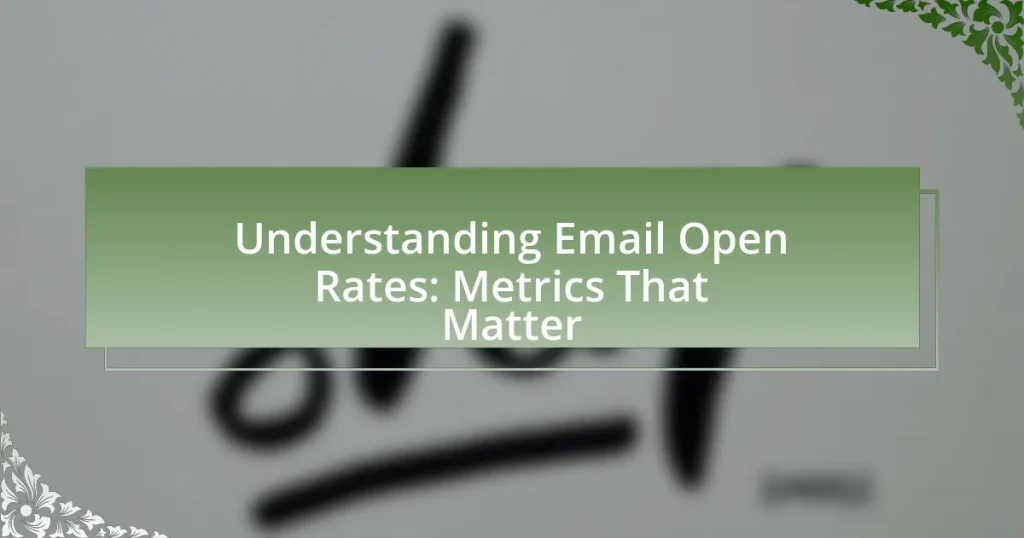Email open rates are a critical metric in email marketing, representing the percentage of recipients who open a specific email compared to the total delivered. This article explores the significance of email open rates, detailing how they are calculated and the factors influencing them, such as subject line effectiveness, sender reputation, timing, and audience segmentation. It emphasizes the importance of monitoring open rates for businesses to optimize their email campaigns and improve engagement. Additionally, the article provides best practices for enhancing open rates, including personalization, A/B testing, and strategic timing, while also addressing common mistakes to avoid.

What are Email Open Rates and Why Do They Matter?
Email open rates measure the percentage of recipients who open a specific email compared to the total number of emails delivered. This metric is crucial because it indicates the effectiveness of email subject lines, the relevance of content to the audience, and overall engagement levels. According to a 2023 report by Mailchimp, the average open rate across industries is approximately 21.33%, highlighting the importance of optimizing email campaigns to improve this metric. High open rates suggest successful targeting and compelling messaging, while low rates may signal the need for adjustments in strategy.
How is Email Open Rate Calculated?
Email open rate is calculated by dividing the number of unique opens by the number of emails delivered, then multiplying by 100 to get a percentage. For example, if 100 emails are delivered and 20 of them are opened, the open rate would be (20/100) * 100, resulting in a 20% open rate. This metric is essential for assessing the effectiveness of email marketing campaigns and understanding recipient engagement.
What formula is used to determine Email Open Rate?
The formula used to determine Email Open Rate is: (Number of Unique Opens / Number of Emails Delivered) x 100. This calculation provides the percentage of recipients who opened the email compared to those who successfully received it. For example, if 200 emails were delivered and 50 were opened, the Email Open Rate would be (50 / 200) x 100, resulting in a 25% open rate. This metric is crucial for evaluating the effectiveness of email marketing campaigns.
What factors influence the calculation of Email Open Rate?
The calculation of Email Open Rate is influenced by several key factors, including subject line effectiveness, sender reputation, timing of the email, and audience segmentation. Subject lines that are engaging and relevant can significantly increase open rates, as they directly impact a recipient’s decision to open an email. Sender reputation, determined by factors such as previous engagement rates and spam complaints, affects deliverability and trust, influencing whether emails land in the inbox or spam folder. Timing also plays a crucial role; emails sent at optimal times for the target audience tend to have higher open rates. Lastly, effective audience segmentation ensures that emails are tailored to specific groups, increasing the likelihood of engagement. These factors collectively shape the overall performance of email campaigns, as evidenced by industry studies showing that personalized emails can achieve open rates up to 29% higher than non-personalized ones.
Why Should Businesses Monitor Email Open Rates?
Businesses should monitor email open rates to gauge the effectiveness of their email marketing campaigns. By tracking open rates, companies can assess how well their subject lines and content resonate with their audience, allowing them to optimize future communications. For instance, a study by Mailchimp found that the average open rate across industries is about 21.33%, indicating that businesses can benchmark their performance against industry standards. Monitoring these rates also helps identify trends over time, enabling businesses to adjust their strategies based on audience engagement and preferences.
How do Email Open Rates impact overall email marketing success?
Email open rates significantly impact overall email marketing success by serving as a primary indicator of audience engagement and interest. High open rates suggest that the subject lines and sender reputation resonate with recipients, leading to increased chances of conversions. For instance, a study by Mailchimp found that the average open rate across all industries is approximately 21.33%, and campaigns that exceed this benchmark often see higher click-through rates and overall engagement. Therefore, monitoring and optimizing email open rates is crucial for enhancing the effectiveness of email marketing strategies.
What insights can be gained from analyzing Email Open Rates?
Analyzing Email Open Rates provides insights into audience engagement and the effectiveness of email marketing strategies. High open rates indicate that subject lines resonate with recipients, while low open rates may suggest a need for improvement in content or targeting. According to a 2022 report by Mailchimp, the average open rate across industries is approximately 21.33%, which serves as a benchmark for evaluating campaign performance. Additionally, segmenting open rates by demographics or behavior can reveal specific audience preferences, enabling marketers to tailor their approaches for better results.

What Factors Affect Email Open Rates?
Email open rates are primarily affected by factors such as subject line effectiveness, sender reputation, timing of the email, and audience segmentation. Subject lines that are engaging and relevant can increase open rates significantly; studies show that 47% of recipients decide whether to open an email based solely on the subject line. Sender reputation, influenced by previous engagement and spam complaints, also plays a crucial role; emails from trusted senders are more likely to be opened. The timing of the email, including the day of the week and time of day, can impact visibility and engagement, with research indicating that emails sent on Tuesdays and Thursdays tend to have higher open rates. Lastly, audience segmentation allows for more personalized content, which can lead to increased relevance and higher open rates, as targeted emails can achieve open rates up to 14% higher than non-segmented emails.
How Does Subject Line Impact Email Open Rates?
Subject lines significantly impact email open rates by influencing recipients’ initial perceptions and decisions to engage with the email. Research indicates that 47% of email recipients decide whether to open an email based solely on the subject line. A compelling subject line can increase open rates by creating curiosity, urgency, or relevance, while a vague or uninteresting subject line can lead to lower engagement. For instance, a study by Mailchimp found that personalized subject lines can improve open rates by 26%. This demonstrates that the effectiveness of subject lines is crucial for maximizing email marketing success.
What characteristics make a subject line effective?
An effective subject line is concise, engaging, and relevant to the content of the email. Conciseness ensures that the subject line is easily readable and fits within the display limits of most email clients, typically around 50 characters. Engagement can be achieved through the use of action-oriented language or personalization, which has been shown to increase open rates by up to 26% according to a study by Experian. Relevance ensures that the subject line accurately reflects the email’s content, which helps to build trust and reduce unsubscribe rates. Therefore, the combination of these characteristics—conciseness, engagement, and relevance—contributes significantly to the effectiveness of a subject line in improving email open rates.
How can A/B testing improve subject line effectiveness?
A/B testing can improve subject line effectiveness by allowing marketers to compare two or more variations of subject lines to determine which one generates higher open rates. This method provides data-driven insights into audience preferences, enabling marketers to refine their messaging based on actual performance rather than assumptions. For instance, a study by Campaign Monitor found that emails with optimized subject lines can increase open rates by up to 50%. By systematically testing different elements such as wording, length, and personalization, marketers can identify the most compelling subject lines that resonate with their target audience, ultimately enhancing engagement and conversion rates.
What Role Does Timing Play in Email Open Rates?
Timing significantly influences email open rates, as the day and time an email is sent can determine its visibility and likelihood of being opened. Research indicates that emails sent on Tuesdays and Thursdays generally achieve higher open rates, with optimal sending times often identified as mid-morning or early afternoon. For instance, a study by Mailchimp found that emails sent between 10 AM and 11 AM had the highest open rates, suggesting that recipients are more likely to engage with emails when they are actively checking their inboxes. This correlation between timing and open rates underscores the importance of strategic scheduling in email marketing campaigns.
What are the best times to send emails for higher open rates?
The best times to send emails for higher open rates are typically Tuesday through Thursday, between 10 AM and 2 PM. Research indicates that emails sent during these days and times tend to achieve the highest engagement levels. A study by Mailchimp found that emails sent on Tuesdays had an open rate of 20.81%, while those sent on Thursdays had an open rate of 20.55%. Additionally, sending emails during mid-morning and early afternoon aligns with common work schedules, increasing the likelihood that recipients will check their inboxes.
How does audience segmentation affect timing strategies?
Audience segmentation significantly influences timing strategies by allowing marketers to tailor their communication based on the specific preferences and behaviors of different audience groups. For instance, research indicates that segmented email campaigns can achieve open rates that are 14% higher than non-segmented campaigns, demonstrating that timing can be optimized when messages are aligned with the audience’s habits. By analyzing data such as past engagement times and demographic factors, marketers can determine the most effective times to send emails, ensuring that messages reach recipients when they are most likely to engage. This strategic alignment between audience characteristics and timing enhances overall campaign effectiveness and improves open rates.

What Are the Best Practices for Improving Email Open Rates?
To improve email open rates, utilize personalized subject lines, segment your audience, and optimize send times. Personalized subject lines increase open rates by 26%, as they resonate more with recipients. Audience segmentation allows for targeted messaging, leading to higher engagement; for instance, segmented campaigns can achieve 14.31% higher open rates compared to non-segmented ones. Additionally, sending emails at optimal times, such as mid-week mornings, can significantly enhance visibility in crowded inboxes, as studies show that emails sent during these times have higher open rates.
How Can Personalization Enhance Email Open Rates?
Personalization can significantly enhance email open rates by making the content more relevant to the recipient. When emails are tailored to individual preferences, behaviors, or demographics, recipients are more likely to engage with the subject line and open the email. According to a study by Experian, personalized emails have an open rate that is 29% higher than non-personalized emails. This increase is attributed to the perception of value and connection that personalized content creates, leading to improved engagement and response rates.
What types of personalization can be implemented in emails?
Personalization in emails can be implemented through several types, including demographic personalization, behavioral personalization, and contextual personalization. Demographic personalization involves using recipient data such as age, gender, and location to tailor content. Behavioral personalization utilizes past interactions, such as previous purchases or email engagement, to customize future messages. Contextual personalization adapts content based on the current situation or environment of the recipient, such as time of day or device used. These methods enhance engagement, as studies show that personalized emails can increase open rates by up to 29% and click-through rates by 41%, demonstrating their effectiveness in improving email marketing outcomes.
How does personalization affect recipient engagement?
Personalization significantly enhances recipient engagement by making communications more relevant and tailored to individual preferences. When emails are personalized, such as by including the recipient’s name or suggesting products based on past behavior, open rates can increase by up to 26%, according to a study by Experian. This relevance fosters a stronger connection between the sender and the recipient, leading to higher click-through rates and overall engagement. Personalization not only captures attention but also encourages recipients to interact with the content, ultimately driving better results for email marketing campaigns.
What Strategies Can Be Used to Optimize Email Campaigns?
To optimize email campaigns, implement segmentation, personalization, A/B testing, and analyze engagement metrics. Segmentation allows targeting specific audience groups, increasing relevance and open rates. Personalization enhances user experience by tailoring content to individual preferences, which can lead to higher engagement. A/B testing different subject lines, content formats, and send times helps identify the most effective strategies, improving overall performance. Analyzing engagement metrics, such as open rates and click-through rates, provides insights into what resonates with the audience, enabling continuous improvement. According to a study by Mailchimp, segmented campaigns can achieve up to 14.31% higher open rates compared to non-segmented ones, validating the effectiveness of these strategies.
How can list segmentation improve open rates?
List segmentation can improve open rates by allowing marketers to tailor their email content to specific audience groups. When emails are customized based on demographics, interests, or past behaviors, recipients are more likely to find the content relevant, leading to higher engagement. Research indicates that segmented campaigns can result in a 14.31% higher open rate compared to non-segmented campaigns, as shown in a study by Mailchimp. This targeted approach ensures that the right message reaches the right audience, significantly enhancing the likelihood of email opens.
What role does mobile optimization play in email engagement?
Mobile optimization significantly enhances email engagement by ensuring that emails are easily readable and navigable on mobile devices. With over 50% of emails opened on mobile platforms, optimized layouts, responsive design, and fast loading times directly contribute to higher open and click-through rates. Research from Litmus indicates that mobile-friendly emails can increase engagement by up to 15%, demonstrating the critical importance of mobile optimization in capturing and retaining audience attention.
What Common Mistakes Should Be Avoided to Maintain High Open Rates?
To maintain high open rates, avoid common mistakes such as using misleading subject lines, neglecting audience segmentation, and failing to optimize send times. Misleading subject lines can lead to distrust, causing recipients to ignore future emails; studies show that 69% of email recipients report email as spam based solely on the subject line. Neglecting audience segmentation results in irrelevant content being sent to recipients, which can decrease engagement; targeted emails can achieve 18 times more revenue than broadcast emails. Lastly, failing to optimize send times can significantly impact open rates, as emails sent at optimal times can increase open rates by 20-30%.
How can poor list management negatively impact open rates?
Poor list management can significantly reduce open rates by leading to the inclusion of unengaged or irrelevant subscribers. When email lists contain outdated or incorrect addresses, the likelihood of emails being opened diminishes, as recipients may not recognize the sender or may have lost interest. According to a study by Mailchimp, segmented campaigns can see open rates as high as 14.32%, while non-segmented lists often experience rates below 10%. This demonstrates that effective list management, which includes regular cleaning and segmentation, is crucial for maintaining high engagement levels and improving open rates.
What are the consequences of using misleading subject lines?
Using misleading subject lines can lead to decreased trust and engagement from recipients. When recipients realize that the content does not match the subject line, they may feel deceived, resulting in higher unsubscribe rates and lower open rates for future emails. According to a study by HubSpot, 69% of consumers report that they would mark an email as spam if the subject line is misleading. This behavior can damage the sender’s reputation and affect deliverability rates, as email service providers may flag the sender as untrustworthy.
What Tools and Metrics Can Help Track Email Open Rates Effectively?
To track email open rates effectively, tools such as email marketing platforms (e.g., Mailchimp, Constant Contact) and analytics software (e.g., Google Analytics) are essential. These platforms provide built-in metrics that measure open rates by tracking unique opens and total opens through embedded tracking pixels. For instance, Mailchimp reports that the average open rate across all industries is around 21.33%, which highlights the importance of using these tools to benchmark performance. Additionally, metrics like click-through rates and engagement rates complement open rate data, offering a comprehensive view of email campaign effectiveness.
Which analytics tools are best for monitoring Email Open Rates?
The best analytics tools for monitoring Email Open Rates include Mailchimp, HubSpot, and Constant Contact. Mailchimp provides detailed reports on open rates and engagement metrics, allowing users to analyze the effectiveness of their email campaigns. HubSpot offers comprehensive analytics that track email performance, including open rates, click-through rates, and user engagement over time. Constant Contact also features robust reporting tools that help users monitor open rates and optimize their email marketing strategies. These tools are widely recognized for their effectiveness in providing actionable insights into email performance.
How can metrics be interpreted to improve future campaigns?
Metrics can be interpreted to improve future campaigns by analyzing key performance indicators such as open rates, click-through rates, and conversion rates. By examining open rates, marketers can identify which subject lines and send times yield the highest engagement, allowing for optimization in future email strategies. For instance, a study by Mailchimp found that emails sent on Tuesdays had a 20% higher open rate compared to those sent on Fridays. Additionally, analyzing click-through rates can reveal which content resonates most with the audience, guiding the creation of more targeted and relevant content in subsequent campaigns. By continuously monitoring these metrics, marketers can make data-driven decisions that enhance the effectiveness of their email campaigns.
What Practical Tips Can Help Increase Email Open Rates?
To increase email open rates, focus on crafting compelling subject lines, personalizing content, and optimizing send times. Compelling subject lines can boost open rates by up to 50%, as they create curiosity and urgency. Personalization, such as using the recipient’s name or tailoring content to their interests, can lead to a 26% increase in open rates. Additionally, sending emails at optimal times, based on audience behavior, can significantly enhance visibility; studies show that emails sent on Tuesdays and Thursdays tend to have higher open rates.



